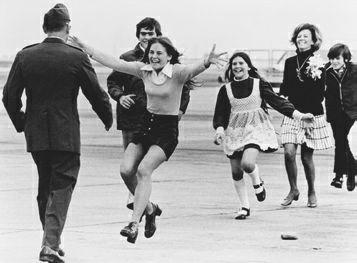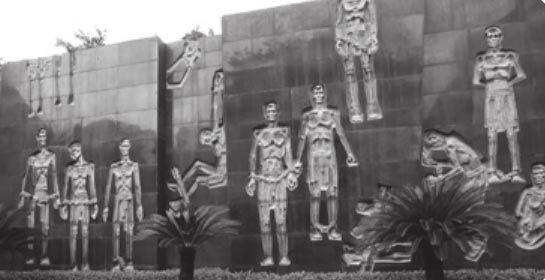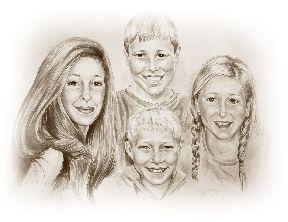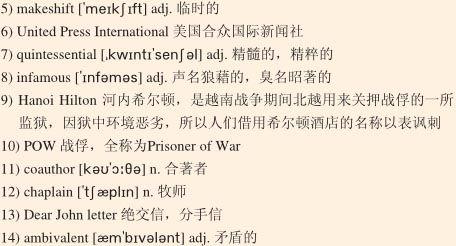返乡
by Carolyn Kleiner Butler

The minutes crept by like hours,” she recalls, and then, all at once, the car door opened. “I just wanted to get to Dad as fast as I could,” Lorrie says. She tore down the runway toward him with open arms, her spirits—and feet—flying. Her mother, Loretta, and three younger 1)siblings—Robert, Roger and Cindy—were only steps behind. “We didnt know if he would ever come home,” Lorrie says. “That moment was all our prayers answered, all our wishes come true.”
2)Associated Press photographer Slava Veder, whod been standing in a crowded bullpen with dozens of other journalists, noticed the 3)sprinting family and started taking pictures. “You could feel the energy and the raw emotion in the air,” says Veder, then 46, who had spent much of the Vietnam era covering antiwar demonstrations in San Francisco and 4)Berkeley. The day was overcast, meaning no shadows and near-perfect light.He rushed to a 5)makeshift darkroom in a ladies bathroom on the base (6)United Press International had commandeered the mens). In less than half an hour, Veder and his AP colleague Walt Zeboski had developed six remarkable images of that singular moment. Veders pick, which he instantly titled Burst of Joy, was sent out over the newsservice wires, published in newspapers around the nation and went on to win a Pulitzer Prize in 1974.
It remains the 7)quintessential homecoming photograph of the time. Stirm, 39, who had endured gunshot wounds, torture, illness, starvation and despair in North Vietnamese prison camps, including the 8)infamous 9)Hanoi Hilton, is pictured in a crisp new uniform. Because his back is to the camera, as Veder points out, the officer seems anonymous, an everyman who represented not only the hundreds of 10)POWs released that spring but all the troops in Vietnam who would return home to the mothers, fathers, wives, daughters and sons theyd left behind. “Its a heros welcome for guys who werent always seen or treated as heroes,” says Donald Goldstein, a retired Air Force lieutenant colonel and 11)coauthor of The Vietnam War: The Stories and The Photographs. “After years of fighting a war we couldnt win, a war that tore us apart, it was finally over, and the country could start healing.”
But there was more to the story than was captured on film. Three days before Stirm landed at Travis Air Force Base, a 12)chaplain had handed him a 13)Dear John letter from his wife. “I cant help but feel 14)ambivalent about it,” Stirm says today of the photograph. “I was very pleased to see my children—I loved them all and still do, and I know they had a difficult time—but there was a lot to deal with.”
Lorrie says, “So much had happened—there was so much that my dad missed out on—and it took a while to let him back into our lives and accept his authority.”
Her parents were divorced within a year of his return. Her mother remarried in 1974 and lives in Texas with her husband. Stirm retired from the Air Force as a colonel in 1977 and worked as a corporate pilot and businessman. He married and was divorced again. Now 72 and retired, he lives in Foster City, California.
As for the rest of the family, Robert is a dentist in 15)Walnut Creek, California; he and his wife have four children, the oldest of whom is a marine. Roger, a major in the Air Force, lives outside 16)Seattle. Cindy, a waitress, resides in Walnut Creek with her husband and has a daughter in college. And Lorrie, now 47, is an executive administrator and mother of two sons. She lives in 17)Mountain View, California, with her husband. All four of Stirms children have a copy of Burst of Joy hanging in a place of honor on their walls. But he says he cant bring himself to display the picture.
Three decades after the Stirm reunion, the scene, having appeared in countless books, anthologies and exhibitions, remains part of the nations collective consciousness, often serving as an 18)uplifting postscript to Vietnam. That the moment was considerably more fraught than we first assumed makes it all the more 19)poignant and reminds us that not all war casualties occur on the battlefield.
Lorrie says, “Every time I look at the picture, I remember the families that werent reunited, and the ones that arent being reunited today—many, many families—and I think, Im one of the lucky ones.”
那几分钟慢得就好像几个小时一样,”她回忆道,然后,突然间,车门开了。“我只想尽快跑到爸爸身边,”洛丽说。当时,她沿着跑道,张开双臂,朝着父亲冲了过去,她的心情——和脚步——都飞了起来。她的妈妈洛雷塔,还有三个弟妹——罗伯特、罗杰和辛迪——紧随其后。“之前,我们都不晓得他还能不能回来,”洛丽说。“那一刻,我们所有的祝祷都得到了回应,我们所有的愿望都得以实现。”
美联社摄影记者斯拉瓦·韦德注意到了这个飞奔着团聚的家庭并开始拍照,当时他正与其他几十个记者挤在采访区里。“你能感受到空气中那股能量与真情实感,”韦德说道,那时他46岁,越战时期,他主要在旧金山和伯克利市报道反战游行。那天是个阴天,没有任何阴影,并且光线也近乎完美。
拍完照片,他立刻冲到了设在基地女厕所中的临时暗房(美国合众国际新闻社占用了男厕)。不到半小时,韦德和他美联社的同事沃尔特·奇博斯基便洗出了定格那非凡时刻的六张出色照片。韦德选出一张,立马将其命名为“迸发的喜悦”,发送给新闻社,美国全国各地的报纸上都刊登了这张照片。1974年,这张照片更获得了普利策奖。
这张照片仍是那个年代壮士归故里的经典照片。照片上穿着崭新军装的斯特姆,时年39岁,在北越的战俘营里,包括那臭名昭著的河内希尔顿战俘营,受过枪伤、拷问,熬过疾病、饥饿和绝望。正如韦德所指出的,因为斯特姆背对镜头,所以这名军官看似一个隐匿无名的普通人,不光代表着那年春天被释放的数以百计的战俘,也代表了即将从越南返家回到父母妻儿身边的整支军队。“对于并不时常被视作英雄及受到英雄礼遇的人来说,这是种对待英雄般的欢迎,” 唐纳德·戈尔茨坦说道,他是一名退役的空军中校以及《越南战争:故事与照片》一书的合著者。“这场我们打不赢的战争持续了好几年,将我们艰难地分开,它终于结束了,国家也可以开始休养生息了。”
但是,除了被胶卷捕捉的那一幕,那个家庭还有着更多的故事。就在斯特姆于特拉维斯空军基地着陆的三天前,牧师把他妻子写给他的分手信交给了他。“我不禁对这次团聚感到矛盾,”现今的斯特姆谈起那张照片时说道,“我很高兴看到我的孩子们——我爱他们,如今也是,我也知道他们有过一段艰难的时光——但是有太多事要处理。”
洛丽说:“发生了太多太多事——父亲错过了太多的事情——让父亲重归我们的生活并接纳他成为一家之主需要花一段时间。”
洛丽的父亲回来后不到一年她的父母便离婚了。她的母亲于1974年再婚,并与其丈夫住在德克萨斯州。1977年,斯特姆以上校的身份从空军退役并当起了私人飞行员和商人。他再婚后又再度离婚。如今他72岁,也已退休,住在加州福斯特市。
至于这个家庭的其他成员,罗伯特在加州的沃尔纳特克里克市当牙医;他和妻子育有四个孩子,年纪最大的一个是名海军士兵。罗杰是位空军少校,住在西雅图市的郊区。辛迪是名服务生,与丈夫住在沃尔纳特克里克市,并育有一女,正在读大学。还有洛丽,现年47岁,是个行政总监及两个儿子的母亲。她与丈夫住在加州的芒廷维尤市。在斯特姆四个孩子家中,墙上显眼的地方都挂着一幅《迸发的喜悦》。但斯特姆说他自己却不敢挂这幅照片。
斯特姆一家相聚的三十年后,那一幕,曾无数次在书籍、选集以及展览中出现,至今仍是美国集体记忆中的一部分,时常充当着越战的一道振奋人心的注脚。但实际上那个瞬间比我们最初想象的要忧伤得多,这使得它尤显凄美,同时提醒了我们:战争中的伤亡并非只是发生在战场上。
洛丽说:“每每看着那张照片,我都会想起当时那些没能团聚的家庭,还有当下那些不能团聚的家庭——太多太多家庭——我觉得,我是幸运的一个。”

